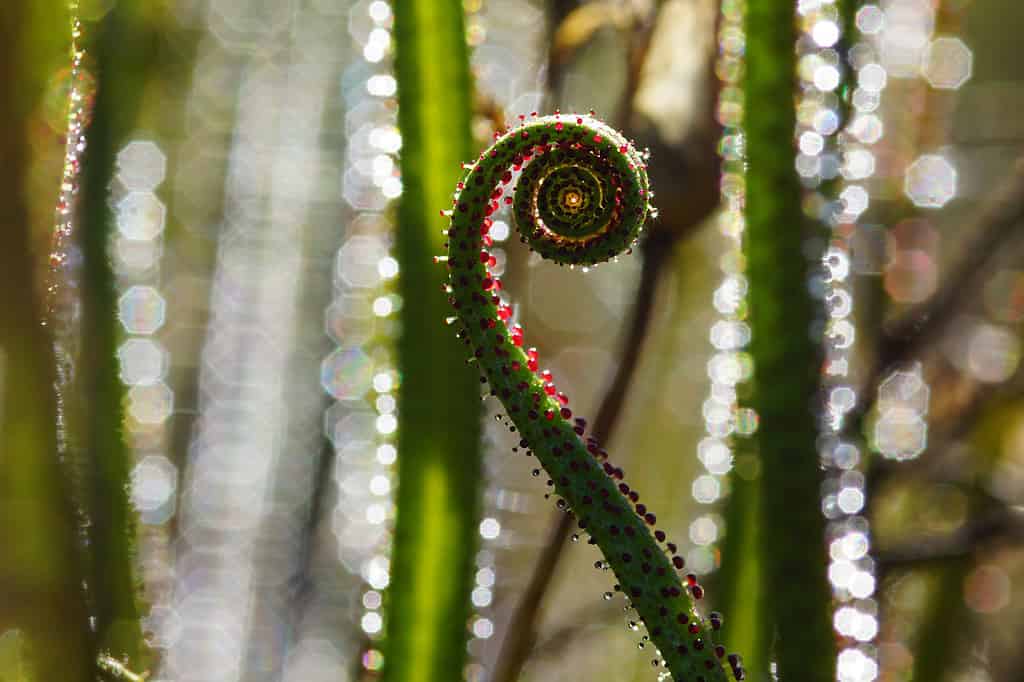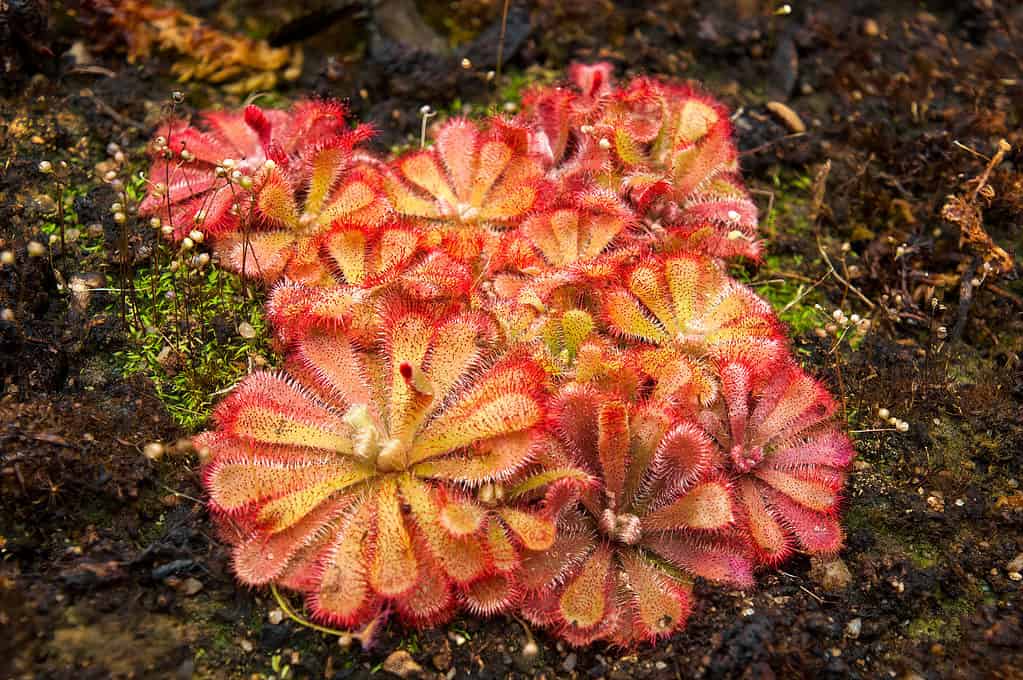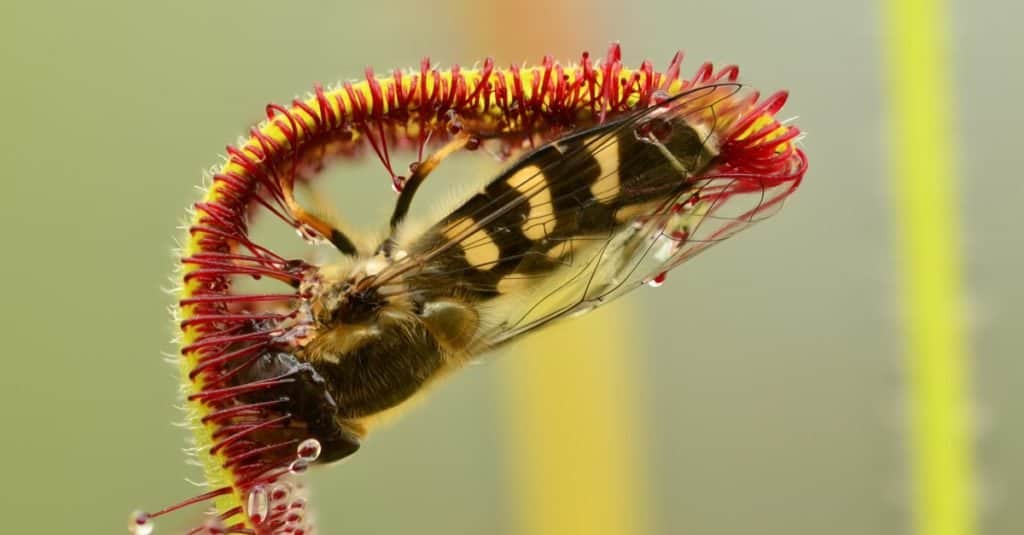If you’ve ever been fascinated by the mesmerizing world of carnivorous plants, growing sundew plants from seed is an exciting adventure waiting to unfold. Sundews, with their delicate, glistening tentacles, lure and capture unsuspecting insects, making them a captivating addition to any plant enthusiast’s collection. They are also known for being voracious eaters and are willing to munch on way more insects than their cousin, the Venus Flytrap.
In this guide, we’ll dive into the thrilling process of raising sundew plants from tiny seeds. With a few simple steps and some patience, you can nurture these remarkable insect-eating wonders right in your own home.
What is a Sundew Plant?
The sundew plant, scientifically classified as Drosera, is a captivating and unique botanical marvel that hails from various corners of the globe. Known for its carnivorous tendencies, this plant exhibits a fascinating blend of beauty and adaptability that sets it apart from its non-carnivorous counterparts.
Classification
The sundew plant belongs to the Droseraceae family and encompasses nearly 200 distinct species. These species are further categorized into three subgenera: Drosera, Ergaleium, and Lasiocephala. Within these subgenera, sundews vary in size, shape, and habitat preferences, showcasing the rich diversity within this unique group of plants.
Native Origin
Sundew plants have a global presence, inhabiting regions spanning from the Americas to Australia. The majority of sundew species, however, find their native homes in nutrient-poor, acidic environments, such as bogs, wetlands, and heathlands. Notable locations for sundew sightings include North and South America, Europe, Africa, Asia, and Australia.
Unique Traits
One of the most remarkable features of sundews is their carnivorous habit. To supplement their nutrient-deficient surroundings, sundew plants have evolved specialized mechanisms to capture and digest small insects and arachnids. Their leaves are adorned with glistening, sticky tentacles, each lined with tiny, hair-like structures known as trichomes. When unsuspecting prey lands on these leaves, they become ensnared in the adhesive secretions.
There’s also this plant’s enzymatic digestion. Once trapped, sundews secrete enzymes that break down the captured prey, converting it into essential nutrients like nitrogen and phosphorus. This nutrient acquisition strategy enables sundews to thrive in environments where other plants would struggle to survive.
Appearance
Sundew plants exhibit a wide range of sizes and shapes, but they all share certain distinctive features:
- Sticky Tentacles: The most recognizable aspect of sundews is their sticky tentacles, which adorn the leaves and sparkle like morning dew in the sunlight. These tentacles are equipped with glandular structures that release digestive enzymes upon capturing prey.
- Rosette Growth: Most sundews grow in a rosette formation, with leaves arranged in a circular pattern around a central point. This rosette shape helps to maximize their exposure to potential prey.
- Color Variations: Sundew leaves come in various colors, from shades of green to vibrant red or pink, often enhancing their allure to insects. This vivid coloration helps attract potential prey by mimicking the appearance of edible flowers.
Habitat and Adaptations
Sundew plants are well-suited to their challenging habitats. They thrive in locations with poor soil conditions because they can extract essential nutrients from their prey. Additionally, their carnivorous nature acts as a form of pest control, as sundews consume insects that might otherwise harm neighboring vegetation.
Reproduction
Sundews typically reproduce through both seeds and vegetative propagation. Some species produce tiny seeds, which can be dispersed by the wind or carried by water. In contrast, others can reproduce by forming offshoots or “daughter plants” near the base of the parent plant. This ability for vegetative reproduction allows sundews to colonize new areas quickly.

or the Portugeuese sundew (pictured) is just one of many different types and species of sundew plants, all of which have the unique carnivorous plant feeding response.
©anjahennern/Shutterstock.com
Are Sundew Plants Hard to Grow?
Sundew plants, known for their carnivorous habits and striking appearance, are intriguing choices for home cultivation. However, their distinct needs can make them a bit more demanding to grow compared to conventional houseplants.
Moderate Difficulty
Growing sundew plants at home falls into the category of moderately challenging. While they’re not the most demanding plants, they do require specific conditions that can be tricky to replicate indoors.
Patience and Observation
Caring for sundews necessitates a keen eye and patience. You’ll need to closely monitor their well-being, making adjustments as needed to maintain their health and vitality.
Adaptation to Home Conditions
Sundews are naturally adapted to their native environments, which might differ significantly from the conditions inside your home. Creating a suitable habitat for them may involve some trial and error.
Seasonal Variations
Sundew plants can respond differently to changing seasons. You might need to adapt your care routine to accommodate temperature and humidity fluctuations throughout the year.
With all of this in mind, let’s explore how to grow sundew plants from seeds!

Most sundew plants do not grow very large.
Drosera aliciaeor the Alice sundew (pictured), for example, rarely get larger than 15 inches at its largest.
©iStock.com/Karin de Mamiel
How to Grow a Sundew Plant From Seed
Cultivating sundew plants can be a fascinating and rewarding endeavor, offering a unique opportunity to observe nature’s carnivorous wonders up close. These captivating plants, known for their sticky, glistening tentacles and insect-devouring habits, can thrive in a well-maintained home environment. In this step-by-step guide, we’ll explore how to grow sundew plants successfully, from selecting the right species to providing proper care.
Step 1: Choose the Right Sundew Species
Before you embark on your sundew-growing journey, it’s crucial to select the right species for your conditions and preferences. Sundews come in various sizes, shapes, and colors, each with its unique characteristics. Consider factors such as available space, lighting conditions, and your level of gardening expertise. Some common sundew species suitable for beginners include Drosera capensis, Drosera spatulata, and Drosera adelae.
Step 2: Gather the Necessary Supplies
To create a suitable environment for your sundew plant, gather the following supplies:
- A container or pot with good drainage: Opt for a container with a lid or clear plastic cover to maintain humidity levels.
- Suitable potting medium: A mix of sphagnum moss, perlite, and sand is ideal, as it provides good aeration and drainage.
- Distilled or rainwater: Sundews are sensitive to minerals in tap water, so avoid using it for watering.
- Small insects: To satisfy your sundew’s carnivorous appetite, you’ll need a source of small insects like fruit flies or gnats.
Step 3: Prepare the Container and Potting Mix
Ensure your container or pot has adequate drainage holes to prevent waterlogged soil, which can harm sundew plants. Create the potting mix by combining sphagnum moss, perlite, and sand in equal parts. This mixture provides the right balance of moisture retention and aeration, mimicking the sundew’s natural habitat.
Step 4: Plant the Sundew
Carefully transplant your sundew into the prepared container, ensuring that the roots are covered with the potting mix but that the leaves and sticky tentacles remain above the surface. Gently pat down the potting mix to secure the plant in place.
Step 5: Provide the Right Lighting
Sundews require bright, indirect sunlight or dappled shade to thrive. Place your container in a location where it can receive ample light without being exposed to direct sunlight for prolonged periods. A sunny windowsill or the use of grow lights can help create the appropriate lighting conditions.
Step 6: Maintain Proper Humidity
Sundew plants naturally grow in humid environments, so it’s essential to maintain the right humidity levels. If you’re growing sundews indoors, consider using a humidity tray or a humidifier to keep the air around your plant adequately moist.
Step 7: Watering
Watering sundew plants requires care and attention. Always use distilled or rainwater, as tap water can contain minerals that are harmful to these sensitive plants. Water your sundew regularly to keep the potting mix consistently moist but not waterlogged. It’s better to water from below by placing the container in a tray of water and allowing the potting mix to absorb moisture through the drainage holes. Avoid overhead watering, as this can wash away the sticky tentacle secretions.
Step 8: Feeding
One of the most fascinating aspects of growing sundew plants is their carnivorous nature. To thrive, sundews need a source of small insects for nutrients. You can provide them with tiny insects like fruit flies or gnats by placing them directly on the sticky tentacles. Your sundew will capture, digest, and absorb the nutrients from these insects.
Step 9: Monitor and Adjust
Regularly inspect your sundew plant for signs of health or stress. Keep an eye on the color and condition of its leaves and tentacles, as well as any potential pests. If you notice any issues, such as browning leaves or pest infestations, take appropriate action promptly. Adjust care routines as needed to accommodate seasonal variations in temperature and humidity.
Step 10: Enjoy the Experience
Growing sundew plants is not just about tending to their needs; it’s also about the experience of observing these unique carnivorous plants in action. Take time to appreciate the intricate beauty of your sundew as it captures and digests its prey. It’s a remarkable opportunity to connect with the wonders of the natural world from the comfort of your home.

Sundew plants can eat a wide variety of living creatures, including mosquitoes, flies, gnats, wasps, ants, and more. They are also known for being hearty eaters and will consume a lot more food than Venus Flytraps, for example.
©Robert Evenflow/Shutterstock.com
Care Tips for Sundew Plants
To help you achieve success in cultivating sundews, there are some essential tips and tricks to keep in mind.
Understand Your Sundew’s Species
Before diving into sundew care, it’s crucial to understand the specific species you’re dealing with. Sundews come in various sizes, shapes, and colors, and each species may have slightly different care requirements. For example, some are more tolerant of environmental fluctuations than others. Therefore, take the time to research and identify the particular species you have to tailor your care accordingly.
Create the Right Environment
Sundews originate from a variety of habitats, from bogs to heathlands. Replicating these conditions is key to their well-being. While providing the right lighting and humidity is crucial, you should also consider temperature. Most sundews prefer warm, temperate conditions. However, some species, like Drosera binata, thrive in cooler environments. Be sure to match your sundew’s needs with the appropriate environment.
Water Wisely
Proper watering is essential for sundew health. As mentioned earlier, sundews are sensitive to minerals found in tap water, so it’s crucial to use distilled or rainwater. When watering, avoid soaking the entire potting mix; instead, water from below by placing the container in a tray of water and allowing the potting mix to absorb moisture through the drainage holes. This mimics the way they absorb water in the wild, and it also prevents the disruption of their sticky tentacles.
Feed Thoughtfully
Sundews are insectivorous, but they don’t require a constant supply of insects to thrive. While they can capture their prey, you can supplement their diet with small insects like fruit flies or gnats. However, avoid overfeeding, as excess prey can lead to overcrowded leaves and potential rot. A balanced diet and occasional fasting can be beneficial.
Pruning and Maintenance
To ensure your sundew continues to thrive, it’s essential to regularly inspect and maintain the plant. Remove dead or decaying leaves by gently pinching them off. This helps the plant allocate its energy more efficiently and keeps it looking tidy. Additionally, if you notice overcrowding or congestion of leaves, thin them out to allow for better air circulation.
Prevent Pests
While sundews are natural insect predators, they can still fall victim to common pests like aphids or spider mites. Regularly check for signs of infestations, such as discolored or damaged leaves. If pests are present, consider using natural remedies like neem oil or insecticidal soap to control the problem. Quarantine new plants before introducing them to your collection to prevent potential pest outbreaks.
Adjust for Seasonal Changes
Sundew plants can respond differently to changing seasons. During the growing season, which typically spans spring and summer, they are more active and may require more frequent feeding. However, as winter approaches, many sundews enter a dormant period. During this time, they may produce fewer leaves and require less water and food. Adjust your care routine accordingly to accommodate these seasonal changes.
Learn from Experience
Growing sundew plants can be a learning experience. Don’t be discouraged by setbacks or challenges along the way. Instead, view them as opportunities to improve your care techniques. Experiment with different lighting conditions, potting mixes, and feeding schedules to see what works best for your specific plants. Over time, you’ll develop a better understanding of your sundews’ unique needs.
Connect with Fellow Enthusiasts
Joining online forums or local gardening clubs can provide a wealth of knowledge and support. Engaging with fellow sundew enthusiasts allows you to exchange tips, troubleshoot problems, and learn from their experiences. Whether you’re a beginner or an experienced grower, the shared passion for these remarkable plants can foster a sense of community and camaraderie.
Growing sundew plants can be a fascinating and fulfilling journey for plant enthusiasts. By selecting the right species, providing the necessary supplies, and following these step-by-step instructions, you can create a thriving environment for these captivating carnivorous plants. With patience, attention, and a sense of wonder, you’ll be able to enjoy the unique beauty and behavior of sundew plants in your own home.
Remember that each sundew is unique, and learning from your experiences will help you become a more skilled and knowledgeable grower over time. Ultimately, the journey of nurturing and observing sundew plants in your care is a remarkable and fulfilling endeavor. Happy planting!
The photo featured at the top of this post is © Jeff Holcombe/Shutterstock.com
Thank you for reading! Have some feedback for us? Contact the AZ Animals editorial team.







